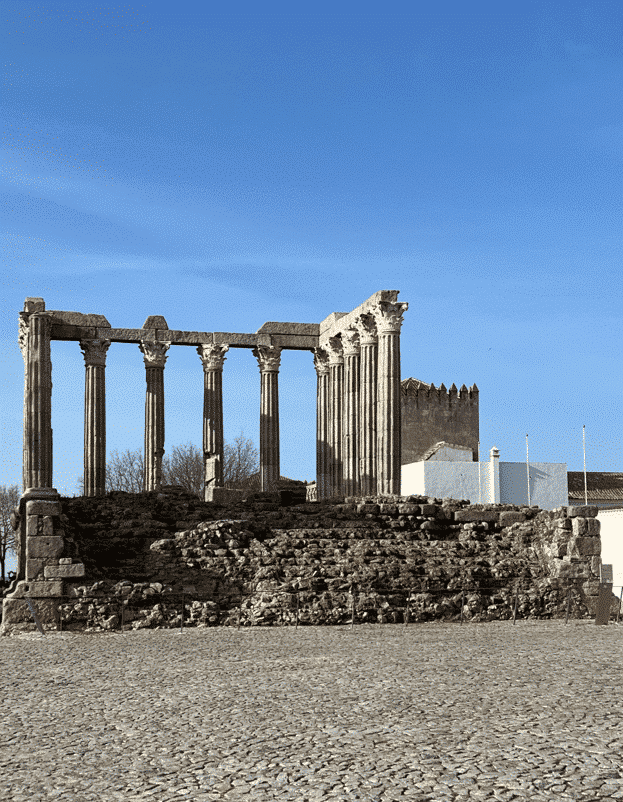Located in the heart of Portugal’s beautiful Alentejo region, Évora is a city steeped in history. Among its many architectural treasures stands one that truly captures the essence of this ancient city – Templo Romano de Évora, also known as Temple of Diana.
A Glimpse into History
The Templo Romano de Évora is believed to have been constructed around the 1st century AD during the reign of Emperor Augustus and it was later modified under Emperor Claudius. This magnificent structure reflects Roman architecture with Corinthian style columns standing on a granite platform. However, despite being commonly referred to as ‘Temple of Diana’, there is no historical evidence supporting that this temple was dedicated to Diana, the Roman goddess of hunting and moonlight.
Surviving Through Ages
The survival story of Templo Romano de Évora through centuries bears witness to its resilience against time and human intervention. It remarkably survived through invasions by Visigoths in 5th century and Moors in 8th century when most other structures were destroyed or extensively modified. In fact, for several centuries after these invasions, it served various purposes including a fortress, a butcher shop during Middle Ages and even an abattoir until late 19th century which surprisingly helped preserve it from further damage.
Architectural Allure
The Temple boasts fourteen original Corinthian columns made from marble quarried nearby at Estremoz. The base podium measures about 15m x 25m x 3m high upon which sits an impressive colonnade originally consisting twenty-six fluted shafts with capitals adorned by acanthus leaves – all typical features reflecting grandeur characteristic to Roman temples.
Restoration Efforts & Recognition
The temple underwent significant restoration efforts in the 19th century under architect Giuseppe Cinatti. The ruins were cleared of extraneous structures and debris, revealing the original grandeur of this Roman edifice. Today, it stands as one of the best preserved Roman temples on the Iberian Peninsula.
In recognition of its historical significance, Évora was declared a UNESCO World Heritage Site in 1986 with Templo Romano de Évora being one among several noteworthy monuments contributing to this status.
Visiting Templo Romano de Évora
Visitors can explore around this remarkable structure for free at any time throughout year as it is located in an open public area. However, there are no entry provisions inside due to preservation concerns. To soak up more about its history and architecture, guided tours are available which provide fascinating insights into its past. It’s particularly stunning during sunset when warm hues bathe over ancient stones creating a magical atmosphere that transports you back through centuries.
Around Templo Romano de Évora
Beyond Temple itself lies charming city of Evora offering myriad attractions like Cathedral Sé de Évora – a mix between Romanesque-Gothic style architecture; University of Evora – Portugal’s second oldest university; Chapel Of Bones (Capela dos Ossos) where walls are lined by human bones and skulls reminding us memento mori (“remember that you will die”). Plus numerous museums such as Museum do Megalitismo showcasing region’s rich megalithic heritage or Regional Wine Cellar featuring Alentejo’s renowned wines offer diverse experiences enriching your visit beyond just exploring historic sites.
In conclusion, whether you’re an avid historian or simply someone who appreciates architectural beauty and cultural richness, visiting Templo Romano de Évora is a journey back in time that you won’t want to miss.
Frequently asked questions
What is the Templo Romano de Évora?
The Templo Romano de Évora, also known as the Temple of Diana, is a well-preserved Roman structure located in the historical city of Évora, Portugal. Believed to have been constructed around the first century A.D., it’s one of the most significant and visible landmarks from Roman times in Portugal. The temple features Corinthian columns and was likely dedicated to Emperor Augustus but got its popular name “Temple of Diana” due to a legend.
What are the opening hours for visiting Templo Romano de Évora?
The beauty of visiting Templo Romano de Évora is that it’s an outdoor monument situated within public gardens called Jardim Diana. Therefore, there are no specific opening or closing times for viewing this ancient architectural marvel from outside. Visitors can walk up close to it at any time during day or night. However, if you wish to visit nearby attractions like Museu de Évora or Cathedral of Evora which have operational timings and entry fees, please check their respective websites for accurate information.
How can I reach Templo Romano de Évora?
To get to Templo Romano De Evóra by car from Lisbon Airport (the closest international airport), take A2 and then exit onto IP7 towards Alcácer do Sal/Évoramonte/Estremoz/Espanha/Santarém/Évoramonte/A6/IP2/Montemor-o-Novo/Vendas Novas. From here continue on N114 straight into central Evóra where you will find signs leading directly towards ‘Tempo De Diana’. If traveling by train or bus from Lisbon Oriente station takes about 1 hour 30 minutes with services provided by Rede Expressos.
What is the historical significance of Templo Romano de Évora?
The Templo Romano is a significant symbol of Roman architecture and culture in Portugal. It was built during the reign of Emperor Augustus, which marked the height of Roman expansion and influence. The temple’s Corinthian style reflects Rome’s artistic development, while its well-preserved state offers insights into ancient construction techniques. Although it has been commonly referred to as “Temple of Diana”, there’s no archaeological evidence linking it directly to this goddess; instead, it was likely used for emperor worship.
Are there any special events or festivals held at Templo Romano de Évora?
While there are no specific events or festivals held within the confines of the temple itself due to preservation efforts, you can find many cultural activities happening around Évora throughout the year. These include Festa da cidade (City Festival) in June celebrating Saint John’s day with concerts and traditional dances, Feira de São João (Saint John’s Fair) also in June offering gastronomic delights and crafts stalls among others. Always check local listings for up-to-date information on current events during your visit period.












